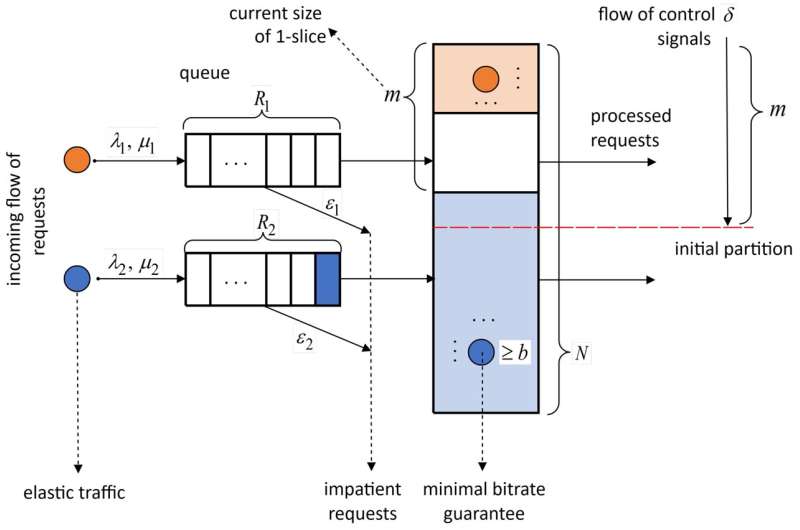This article has been reviewed according to Science X's editorial process and policies. Editors have highlighted the following attributes while ensuring the content's credibility:
fact-checked
trusted source
proofread
Mathematicians build an algorithm for 5G network slicing

One of the features of 5G networks is so-called slicing, which is segmentation of the network. Physically, the network remains the same but is logically divided into slices depending on current requests. This approach guarantees a given level of signal quality. Resources are allocated dynamically to a specific segment: If some resources are not currently being used, they can be redirected to another segment.
It is important to optimize this process so that slicing gives a positive result. RUDN University mathematicians have figured out how best to implement resource distribution in the case when two services share elastic traffic—for example, a browser is running and data is being transferred at the same time. Their research is published in the journal Future Internet.
"Network slicing allows you to deploy independent network resources on the same infrastructure. Using this mechanism, providers can allocate logically isolated network segments to users, each of which is designed and optimized for specific requirements.
"For example, one for cellular communications, and the other for the Internet of Things. Therefore, it is important to study the question of how to organize the redistribution of resources when slicing a 5G network," said Irina Kochetkova, Ph.D., Associate Professor at the Institute of Computer Science and Telecommunications of the RUDN University.
RUDN University mathematicians have built a mathematical model that is based on queuing theory and the Markov decision-making process. Resource allocation is based on three principles: maximum matching for equal resource partitioning, maximum share of signals resulting in resource reallocation, and maximum resource utilization. On this basis, mathematicians built an iterative algorithm for optimal distribution and conducted numerical experiments.
Numerical experiments showed fast convergence, that is, rapid founding of the optimal solution—in just three iterations. This indicates the effectiveness of the proposed approach. The new algorithm converges faster than the so-called brute force method, that is, exhaustive search.
From a numerical experiment, mathematicians were able to conclude what exactly the optimal allocation of resources depends on. These factors turned out to be the current state of the system and the ratio of weights in the reward function—that is, the "importance" of individual parameters in the operation of the algorithm.
"To efficiently calculate the optimal resource scheduling policy, we developed a sequential algorithm. It starts with maximizing resource utilization as a starting point. Using numerical demonstrations, we showed an optimal solution for two services: web browsing and bulk data transfer.
"The algorithm converges quickly in three iterations. It is effective due to a balanced approach based on three principles," said Anastasiya Vlaskina, Ph.D., an assistant at the Institute of Computer Science and Telecommunications of RUDN University.
More information: Irina Kochetkova et al, Controllable Queuing System with Elastic Traffic and Signals for Resource Capacity Planning in 5G Network Slicing, Future Internet (2024). DOI: 10.3390/fi16010018





















